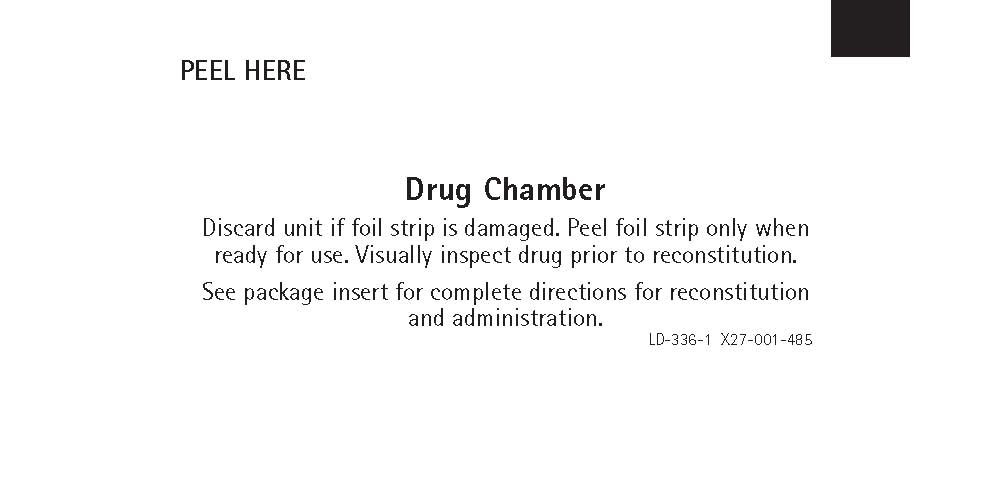Cefepime Hydrochloride and Dextrose: Package Insert / Prescribing Info
Package insert / product label
Generic name: cefepime hydrochloride
Dosage form: injection, solution
Drug class: Fourth generation cephalosporins
J Code (medical billing code): J0703 (500 mg, injection)
Medically reviewed by Drugs.com. Last updated on Mar 27, 2025.
On This Page
- Indications and Usage
- Dosage and Administration
- Dosage Forms and Strengths
- Contraindications
- Warnings and Precautions
- Adverse Reactions/Side Effects
- Drug Interactions
- Use In Specific Populations
- Overdosage
- Description
- Clinical Pharmacology
- Nonclinical Toxicology
- Clinical Studies
- References
- How Supplied/Storage and Handling
- Patient Counseling Information
Highlights of Prescribing Information
CEFEPIME for injection and DEXTROSE injection, for intravenous use
Initial U.S. Approval: 1996
To reduce the development of drug-resistant bacteria and maintain the effectiveness of Cefepime for Injection USP and Dextrose Injection USP and other antibacterial drugs, Cefepime for Injection USP and Dextrose Injection USP should be used only to treat or prevent infections that are proven or strongly suspected to be caused by bacteria. (1)
Indications and Usage for Cefepime Hydrochloride and Dextrose
Cefepime for Injection and Dextrose Injection is a cephalosporin antibacterial indicated in the treatment of the following infections caused by susceptible strains of the designated microorganisms:
- Pneumonia (1.1)
- Empiric therapy for febrile neutropenic patients (1.2)
- Uncomplicated and complicated urinary tract infections (1.3)
- Uncomplicated skin and skin structure infections (1.4)
- Complicated intra-abdominal infections (used in combination with metronidazole) (1.5)
To reduce the development of drug-resistant bacteria and maintain the effectiveness of Cefepime for Injection and Dextrose Injection and other antibacterial drugs, Cefepime for Injection and Dextrose Injection should be used only to treat or prevent infections that are proven or strongly suspected to be caused by bacteria. (1.6)
Cefepime Hydrochloride and Dextrose Dosage and Administration
For intravenous use only administered over approximately 30 minutes. (2)
Use this formulation of cefepime only in adult and pediatric patients who require the entire 1 or 2 gram dose and not any fraction thereof. (2.1, 2.2)
| Recommended Dosing Schedule in Adult Patients with CrCL Greater than 60 mL/min (2.1)* | |||
|---|---|---|---|
| Site and Type of Infection | Dose | Frequency | Duration (days) |
| Moderate to severe pneumonia* | 1 or 2 g IV | Every 8-12 hours | 10 days |
| Empiric therapy for febrile neutropenic patients | 2 g IV | Every 8 hours | 7 days† |
| Mild to moderate uncomplicated or complicated urinary tract infections | 0.5 or 1 g IV | Every 12 hours | 7–10 days |
| Severe uncomplicated or complicated urinary tract infections | 2 g IV | Every 12 hours | 10 days |
| Moderate to severe uncomplicated skin and skin structure infections | 2 g IV | Every 12 hours | 10 days |
| Complicated intra-abdominal infections (used in combination with metronidazole)* | 2 g IV | Every 8-12 hours | 7–10 days |
Pediatric Patients (2 months to 16 years): Recommended Dosage in pediatric patients with CrCl greater than 60 mL/min. (2.2)
- The usual recommended dosage in pediatric patients is 50 mg per kg per dose administered every 12 hours (every 8 hours for febrile neutropenia). (2.2)
- Patient with Renal Impairment: Adjust dose in patients with CrCl less than or equal to 60 mL/min (2.3)
Dosage Forms and Strengths
- Injection: 1 g in 50 mL and 2 g in 50 mL in a DUPLEX® Container (3)
Contraindications
- Patients with known immediate hypersensitivity reactions to cefepime or other cephalosporins, penicillins or other beta-lactam antibacterial drugs. (4)
Warnings and Precautions
- Hypersensitivity reactions: Cross-hypersensitivity may occur in up to 10% of patients with a history of penicillin allergy. If an allergic reaction occurs, discontinue the drug. (5.1)
- Neurotoxicity: May occur especially in patients with renal impairment administered unadjusted doses. If neurotoxicity associated with Cefepime for Injection and Dextrose Injection occurs, discontinue the drug. (5.2)
- Clostridioides difficile-associated diarrhea (CDAD): Evaluate if diarrhea occurs. (5.3)
Adverse Reactions/Side Effects
- The most common adverse reactions (incidence ≥1%) were local reactions, positive Coombs’ test, decreased phosphorous, increased ALT and AST, increased PT and PTT and rash. (6.1)
- At the highest dose (2 g every 8 hours), incidence of adverse reactions was ≥1% for rash, diarrhea, nausea, vomiting, pruritis, fever, and headache. (6.1)
To report SUSPECTED ADVERSE REACTIONS, contact B. Braun Medical Inc. at 1-800-854-6851 or FDA at 1-800-FDA-1088 or www.fda.gov/medwatch.
Drug Interactions
Use In Specific Populations
- Geriatric Use: Serious neurologic adverse reactions have occurred in geriatric patients with renal insufficiency given unadjusted doses of cefepime (5.2, 8.5)
- Pediatric use: Safety and efficacy have not been established in patients less than 2 months of age or for use in any pediatric patients with complicated intra-abdominal infections. (8.4)
See 17 for PATIENT COUNSELING INFORMATION.
Revised: 3/2022
Full Prescribing Information
1. Indications and Usage for Cefepime Hydrochloride and Dextrose
1.1 Pneumonia
Cefepime for Injection and Dextrose Injection is indicated for the treatment of pneumonia (moderate to severe) caused by Streptococcus pneumoniae (including cases associated with concurrent bacteremia), Pseudomonas aeruginosa, Klebsiella pneumoniae, or Enterobacter species.
1.2 Empiric Therapy for Febrile Neutropenic Patients
Cefepime for Injection and Dextrose Injection as monotherapy is indicated for empiric treatment of febrile neutropenic patients. In patients at high risk for severe infection (including patients with a history of recent bone marrow transplantation, with hypotension at presentation, with an underlying hematologic malignancy, or with severe or prolonged neutropenia), antimicrobial monotherapy may not be appropriate. Insufficient data exist to support the efficacy of cefepime monotherapy in such patients [see Clinical Studies (14.1)].
1.3 Uncomplicated and Complicated Urinary Tract Infections (including pyelonephritis)
Cefepime for Injection and Dextrose Injection is indicated for uncomplicated and complicated urinary tract infections (including pyelonephritis) caused by Escherichia coli or Klebsiella pneumoniae when the infection is severe, or caused by Escherichia coli, Klebsiella pneumoniae, or Proteus mirabilis when the infection is mild to moderate, including cases associated with concurrent bacteremia with these microorganisms.
1.4 Uncomplicated Skin and Skin Structure Infections
Cefepime for Injection and Dextrose Injection is indicated in the treatment of uncomplicated skin and skin structure infections caused by Staphylococcus aureus (methicillin-susceptible strains only) or Streptococcus pyogenes.
1.5 Complicated Intra-abdominal Infections
Cefepime for Injection and Dextrose Injection is indicated for complicated intra-abdominal infections (used in combination with metronidazole) caused by Escherichia coli, viridans group streptococci, Pseudomonas aeruginosa, Klebsiella pneumoniae, Enterobacter species, or Bacteroides fragilis [see Clinical Studies (14.2)].
1.6 Usage
To reduce the development of drug-resistant bacteria and maintain the effectiveness of Cefepime for Injection and Dextrose Injection and other antibacterial drugs, Cefepime for Injection and Dextrose Injection should be used only to treat or prevent infections that are proven or strongly suspected to be caused by susceptible bacteria. When culture and susceptibility information are available, they should be considered in selecting or modifying antibacterial therapy. In the absence of such data, local epidemiology and susceptibility patterns may contribute to the empiric selection of therapy.
2. Cefepime Hydrochloride and Dextrose Dosage and Administration
2.1 Dosage for Adults
Cefepime for Injection and Dextrose Injection in the DUPLEX® Container should be used only in patients who require the entire 1 or 2 gram dose and not any fraction thereof.
The recommended adult dosages and routes of administration are outlined in Table 1 below for patients with creatinine clearance greater than 60 mL/min. Administer Cefepime for Injection and Dextrose Injection intravenously over approximately 30 minutes.
| Site and Type of Infection | Dose | Frequency | Duration (days) |
|---|---|---|---|
| Adults | Intravenous (IV) | ||
| Moderate to Severe Pneumonia due to S. pneumoniae, P. aeruginosa*, K. pneumoniae, or Enterobacter species | 1-2 g IV | Every 8 to 12 hours | 10 |
| Empiric therapy for febrile neutropenic patients [see Indications and Usage (1) and Clinical Studies (14)] | 2 g IV | Every 8 hours | 7† |
| Mild to Moderate Uncomplicated or Complicated Urinary Tract Infections, including pyelonephritis, due to E. coli, K. pneumoniae, or P. mirabilis | 0.5-1 g IV | Every 12 hours | 7 to 10 |
| Severe Uncomplicated or Complicated Urinary Tract Infections, including pyelonephritis, due to E. coli or K. pneumoniae | 2 g IV | Every 12 hours | 10 |
| Moderate to Severe Uncomplicated Skin and Skin Structure Infections due to S. aureus or S. pyogenes | 2 g IV | Every 12 hours | 10 |
| Complicated Intra-abdominal Infections (used in combination with metronidazole) caused by E. coli, viridans group streptococci, P. aeruginosa*, K. pneumoniae, Enterobacter species, or B. fragilis. [see Clinical Studies (14)] | 2 g IV | Every 8 to 12 hours | 7 to 10 |
2.2 Pediatric Patients (2 months up to 16 years)
The maximum dose for pediatric patients should not exceed the recommended adult dose. The usual recommended dosage in pediatric patients up to 40 kg in weight for durations as given above for adults is:
- 50 mg per kg per dose, administered every 12 hours for uncomplicated and complicated urinary tract infections (including pyelonephritis), uncomplicated skin and skin structure infections, and pneumonia (see below).
- For moderate to severe pneumonia due to P. aeruginosa give 50 mg per kg per dose, every 8 hours for febrile neutropenic patients.
- 50 mg per kg per dose, every 8 hours for febrile neutropenic patients.
Cefepime for Injection and Dextrose Injection in the DUPLEX® Container is designed to deliver a 1 g or 2 g dose of cefepime. To prevent unintentional overdose, this product should not be used in pediatric patients who require less than the full adult dose of cefepime.
2.3 Dosage Adjustments in Patients with Renal Impairment
Adult Patients
Adjust the dose of Cefepime for Injection and Dextrose Injection in patients with creatinine clearance less than or equal to 60 mL/min, to compensate for the slower rate of renal elimination. In these patients, the recommended initial dose of Cefepime for Injection and Dextrose Injection should be the same as in patients with CrCL greater than 60 mL/min except in patients undergoing hemodialysis. The recommended doses of Cefepime for Injection and Dextrose Injection in patients with renal impairment are presented in Table 2.
Cefepime for Injection and Dextrose Injection in the DUPLEX® Container should be used only in patients who require the entire 1 or 2 gram dose and not any fraction thereof.
When only serum creatinine is available, the following formula (Cockcroft and Gault equation)1 may be used to estimate creatinine clearance [see References (15)].
The serum creatinine should represent a steady state of renal function:
| Males: | Creatinine Clearance (mL/min) = | Weight (kg) × (140-age) |
| 72 × serum creatinine (mg/dL) | ||
| Females: | 0.85 × above value |
| Creatinine Clearance (mL/min) | Recommended Maintenance Schedule | |||
|---|---|---|---|---|
|
||||
| Greater than 60 | 500 mg every 12 hours | 1 g every 12 hours | 2 g every 12 hours | 2 g every 8 hours |
| 30–60 | 500 mg every 24 hours | 1 g every 24 hours | 2 g every 24 hours | 2 g every 12 hours |
| 11–29 | 500 mg every 24 hours | 500 mg every 24 hours | 1 g every 24 hours | 2 g every 24 hours |
| Less than 11 | 250 mg every 24 hours | 250 mg every 24 hours | 500 mg every 24 hours | 1 g every 24 hours |
| Continuous Ambulatory Peritoneal Dialysis (CAPD) | 500 mg every 48 hours | 1 g every 48 hours | 2 g every 48 hours | 2 g every 48 hours |
| Hemodialysis* | 1 g on day 1, then 500 mg every 24 hours thereafter | 1 g every 24 hours | ||
In patients undergoing Continuous Ambulatory Peritoneal Dialysis (CAPD), Cefepime for Injection and Dextrose Injection may be administered at normally recommended doses at a dosage interval of every 48 hours (see Table 2).
In patients undergoing hemodialysis, approximately 68% of the total amount of cefepime present in the body at the start of dialysis will be removed during a 3-hour dialysis period. The dosage of Cefepime for Injection and Dextrose Injection for hemodialysis patients is 1 g on Day 1 followed by 500 mg every 24 hours for the treatment of all infections except febrile neutropenia, which is 1 g every 24 hours.
Cefepime for Injection and Dextrose Injection should be administered at the same time each day and following the completion of hemodialysis on hemodialysis days (see Table 2).
Pediatric Patients
Data in pediatric patients with impaired renal function are not available; however, since cefepime pharmacokinetics are similar in adults and pediatric patients [see Clinical Pharmacology (12.3)], changes in the dosing regimen proportional to those in adults (see Tables 1 and 2) are recommended for pediatric patients.
2.4 Preparation for Use of Cefepime for Injection and Dextrose Injection in DUPLEX® Container
This reconstituted solution is for intravenous use only.
Do not use plastic containers in series connections. Such use would result in air embolism due to residual air being drawn from the primary container before administration of the fluid from the secondary container is complete. If administration is controlled by a pumping device, care must be taken to discontinue pumping action before the container runs dry or air embolism may result.
Parenteral drug products should be inspected visually for particulate matter and discoloration prior to administration. Use only if solution is clear and container and seals are intact.
DUPLEX® Container Storage
- To avoid inadvertent activation, the DUPLEX® Container should remain in the folded position until activation is intended.
Patient Labeling and Drug Powder/Diluent Inspection
- Apply patient-specific label on foil side of container. Use care to avoid activation. Do not cover any portion of foil strip with patient label.
- Unlatch side tab and unfold DUPLEX® Container (see Diagram 1).
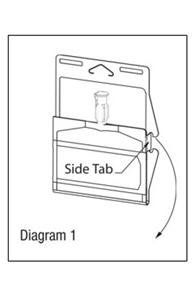
- Visually inspect diluent chamber for particulate matter.
- Use only if container and seals are intact.
- To inspect the drug powder for foreign matter or discoloration, peel foil strip from drug chamber (see Diagram 2).
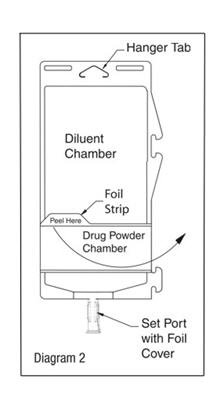
- Protect from light after removal of foil strip.
Note: If foil strip is removed, the container should be re-folded and the side tab latched until ready to activate. The product must then be used within 7 days, but not beyond the labeled expiration date.
Reconstitution (Activation)
- Do not use directly after storage by refrigeration, allow the product to equilibrate to room temperature before patient use.
- Unfold the DUPLEX® container and point the set port in a downward direction. Starting at the hanger tab end, fold the DUPLEX® Container just below the diluent meniscus trapping all air above the fold. To activate, squeeze the folded diluent chamber until the seal between the diluent and powder opens, releasing diluent into the drug powder chamber (see Diagram 3).
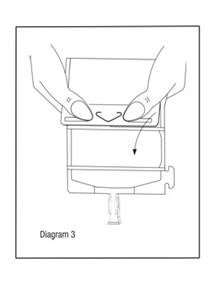
- Agitate the liquid-powder mixture until the drug powder is completely dissolved.
Note: Following reconstitution (activation), product must be used within 12 hours if stored at room temperature or within 5 days if stored under refrigeration.
Administration
- Visually inspect the reconstituted solution for particulate matter.
- Point the set port in a downwards direction. Starting at the hanger tab end, fold the DUPLEX® Container just below the solution meniscus trapping all air above the fold. Squeeze the folded DUPLEX® Container until the seal between reconstituted drug solution and set port opens, releasing liquid to set port (see Diagram 4).
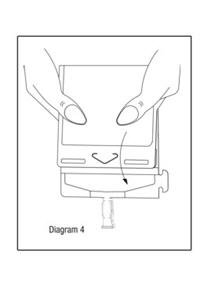
- Prior to attaching the IV set, check for minute leaks by squeezing container firmly. If leaks are found, discard container and solution as sterility may be compromised.
- Using aseptic technique, peel foil cover from the set port and attach sterile administration set (see Diagram 5).
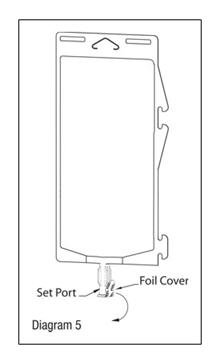
- Refer to directions for use accompanying the administration set.
Important Administration Instructions
- Do not use in series connections.
- Do not introduce additives into the DUPLEX® Container.
- Administer Cefepime for Injection and Dextrose Injection intravenously over approximately 30 minutes.
- Discard unused portions of solutions.
- Intermittent intravenous infusion with a Y-type administration set can be accomplished with compatible solutions. However, during infusion of Cefepime for Injection and Dextrose Injection, it is advisable to discontinue the other solution.
- Solutions of cefepime should not be added to solutions of ampicillin at a concentration greater than 40 mg/mL, and should not be added to metronidazole, vancomycin, gentamicin, tobramycin, netilimicin sulfate or aminophylline because of potential interaction. However, if concurrent therapy with cefepime is indicated, each of these antibacterials can be administered separately.
3. Dosage Forms and Strengths
Dual-chamber, single-dose container:
- 1 g cefepime for injection USP and 50 mL of 5% dextrose injection USP
- 2 g cefepime for injection USP and 50 mL of 5% dextrose injection USP
4. Contraindications
4.1 Hypersensitivity to Cefepime or the Cephalosporin Class of Antibacterials, Penicillins, or Other Beta-lactam Antibacterials
Cefepime for Injection and Dextrose Injection is contraindicated in patients who have shown immediate hypersensitivity reactions to cefepime or the cephalosporin class of antibacterial drugs, penicillins or other beta-lactam antibacterials.
5. Warnings and Precautions
5.1 Hypersensitivity Reactions
Before therapy with Cefepime for Injection and Dextrose Injection is instituted, careful inquiry should be made to determine whether the patient has had previous immediate hypersensitivity reactions to cefepime, cephalosporins, penicillins, or other drugs. Exercise caution if this product is to be given to penicillin-sensitive patients because cross-hypersensitivity among beta-lactam antibacterials has been clearly documented and may occur in up to 10% of patients with a history of penicillin allergy. If an allergic reaction to Cefepime for Injection and Dextrose Injection occurs, discontinue the drug and institute appropriate supportive measures.
5.2 Neurotoxicity
Serious adverse reactions have been reported including life-threatening or fatal occurrences of the following: encephalopathy (disturbance of consciousness including confusion, hallucinations, stupor, and coma), aphasia, myoclonus, seizures, and nonconvulsive status epilepticus [see Adverse Reactions (6.2)]. Most cases occurred in patients with renal impairment who did not receive appropriate dosage adjustment. However, some cases of neurotoxicity occurred in patients receiving a dosage adjustment appropriate for their degree of renal impairment.
In the majority of cases, symptoms of neurotoxicity were reversible and resolved after discontinuation of cefepime and/or after hemodialysis. If neurotoxicity associated with cefepime therapy occurs, discontinue cefepime and institute appropriate supportive measures.
5.3 Clostridioides difficile-Associated Diarrhea
Clostridioides difficile-associated diarrhea (CDAD) has been reported with use of nearly all antibacterial agents, including cefepime, and may range in severity from mild diarrhea to fatal colitis. Treatment with antibacterial agents alters the normal flora of the colon leading to overgrowth of C. difficile.
C. difficile produces toxins A and B, which contribute to the development of CDAD. Hypertoxin-producing strains of C. difficile cause increased morbidity and mortality, as these infections can be refractory to antimicrobial therapy and may require colectomy. CDAD must be considered in all patients who present with diarrhea following antibacterial drug use. Careful medical history is necessary since CDAD has been reported to occur over two months after the administration of antibacterial agents.
If CDAD is suspected or confirmed, ongoing antibacterial use not directed against C. difficile may need to be discontinued. Appropriate fluid and electrolyte management, protein supplementation, antibacterial drug treatment of C. difficile, and surgical evaluation should be instituted as clinically indicated.
5.4 Risk of Development of Drug-resistant Bacteria
Prescribing Cefepime for Injection and Dextrose Injection in the absence of proven or strongly suspected bacterial infection or a prophylactic indication is unlikely to provide benefit to the patient and increases the risk of the development of drug-resistant bacteria.
As with other antimicrobials, prolonged use of Cefepime for Injection and Dextrose Injection may result in overgrowth of nonsusceptible microorganisms. Repeated evaluation of the patient's condition is essential. Should superinfection occur during therapy, appropriate measures should be taken.
5.5 Drug/Laboratory Test Interactions
Urinary Glucose
The administration of cefepime may result in a false-positive reaction with glucose in the urine when using glucose tests based on Benedict’s copper reduction reaction that determine the amount of reducing substances like glucose in the urine. It is recommended that glucose tests based on enzymatic glucose oxidase be used.
Coombs’ Test
Positive direct Coombs' tests have been reported during treatment with cefepime. In patients who develop hemolytic anemia, discontinue the drug and institute appropriate therapy. Positive Coombs' test may be observed in newborns whose mothers have received cephalosporin antibacterial drugs before parturition.
Prothrombin Time
Many cephalosporins, including cefepime, have been associated with a fall in prothrombin activity. Those at risk include patients with renal or hepatic impairment, or poor nutritional state, as well as patients receiving a protracted course of antimicrobial therapy. Prothrombin time should be monitored in patients at risk, and exogenous vitamin K administered as indicated.
5.6 Patients with a History of Gastrointestinal Disease
Cefepime for Injection and Dextrose Injection should be prescribed with caution in individuals with a history of gastrointestinal disease, particularly colitis.
5.7 Possible Effects of Arginine on Glucose Metabolism
Cefepime for Injection and Dextrose Injection contains arginine. Arginine has been shown to alter glucose metabolism and elevate serum potassium transiently when administered at 33 times the amount provided by the maximum recommended human dose of cefepime. The effect of lower doses is not presently known.
5.8 Patients with Overt or Known Subclinical Diabetes Mellitus or Carbohydrate Intolerance
As with other dextrose-containing solutions, Cefepime for Injection and Dextrose Injection should be prescribed with caution in patients with overt or known subclinical diabetes mellitus or carbohydrate intolerance for any reason.
6. Adverse Reactions/Side Effects
The following adverse reactions are discussed in other sections of the labeling:
- Hypersensitivity reactions [see Warnings and Precautions (5.1)]
- Neurotoxicity [see Warnings and Precautions (5.2)]
- Clostridioides difficile-associated diarrhea [see Warnings and Precautions (5.3)]
6.1 Clinical Trials Experience
Because clinical trials are conducted under widely varying conditions, adverse reaction rates observed in the clinical trials of a drug cannot be directly compared to rates in the clinical trials of another drug and may not reflect the rates observed in practice.
In clinical trials using multiple doses of cefepime, 4137 patients were treated with the recommended dosages of cefepime (500 mg to 2 g intravenously every 12 hours). There were no deaths or permanent disabilities thought related to drug toxicity. Sixty-four (1.5%) patients discontinued medication due to adverse reactions thought by the investigators to be possibly, probably, or almost certainly related to drug toxicity. Thirty-three (51%) of these sixty-four patients who discontinued therapy did so because of rash. The percentage of cefepime-treated patients who discontinued study drug because of drug-related adverse reactions was similar at daily doses of 500 mg, 1 g, and 2 g every 12 hours (0.8%, 1.1%, and 2.0%, respectively). However, the incidence of discontinuation due to rash increased with the higher recommended doses.
The following adverse reactions (Table 3) were identified in clinical trials conducted in North America (n=3125 cefepime-treated patients).
|
|
| Incidence equal to or greater than 1% | Local adverse reactions (3%), including phlebitis (1.3%), pain and/or inflammation (0.6%)*; rash (1.1%) |
| Incidence less than 1% but greater than 0.1% | Colitis (including pseudomembranous colitis), diarrhea, erythema, fever, headache, nausea, oral moniliasis, pruritus, urticaria, vaginitis, vomiting, anemia |
At the higher dose of 2 g every 8 hours, the incidence of probably-related adverse reactions was higher among the 795 patients who received this dose of cefepime. Reactions included rash (4%), diarrhea (3%), nausea (2%), vomiting (1%), pruritus (1%), fever (1%), and headache (1%).
The following (Table 4) adverse laboratory changes, irrespective of relationship to therapy with cefepime, were seen during clinical trials conducted in North America.
|
|
| Incidence equal to or greater than 1% | Positive Coombs' Test (without hemolysis) (16.2%); decreased phosphorus (2.8%); increased Alanine Transaminase (ALT) (2.8%), Aspartate Transaminase (AST) (2.4%); eosinophils (1.7%); abnormal PTT (1.6%), Prothrombin Time PT (1.4%) |
| Incidence less than 1% but greater than 0.1% | Increased alkaline phosphatase, Blood Urea Nitrogen (BUN), calcium, creatinine, phosphorus, potassium, total bilirubin; decreased calcium*, hematocrit, neutrophils, platelets, White Blood Cells (WBC) |
A similar safety profile was seen in clinical trials of pediatric patients.
6.2 Postmarketing Experience
The following adverse reactions have been reported during postapproval use of cefepime. Because these reactions are reported voluntarily from a population of uncertain size, it is not always possible to readily estimate their frequency or establish a causal relationship to drug exposure.
In addition to the adverse reactions reported during the North American clinical trials with cefepime, the following adverse reactions have been reported during worldwide postmarketing experience. Encephalopathy (disturbance of consciousness including confusion, hallucinations, stupor, and coma), aphasia, myoclonus, seizures, and nonconvulsive status epilepticus have been reported [see Warnings and Precautions (5.2)].
Anaphylaxis (including anaphylactic shock, transient leukopenia, neutropenia, agranulocytosis and thrombocytopenia) has been reported.
6.3 Cephalosporin-class Adverse Reactions
In addition to the adverse reactions listed above that have been observed in patients treated with cefepime, the following adverse reactions and altered laboratory tests have been reported for cephalosporin-class antibacterials:
Stevens-Johnson syndrome, erythema multiforme, toxic epidermal necrolysis, renal impairment, toxic nephropathy, aplastic anemia, hemolytic anemia, hemorrhage, hepatic impairment including cholestasis, and pancytopenia.
Related/similar drugs
7. Drug Interactions
7.1 Drug/Laboratory Test Interactions
The administration of Cefepime for Injection and Dextrose Injection may result in a false-positive reaction for glucose in the urine with certain methods. It is recommended that glucose tests based on enzymatic glucose oxidase reactions be used.
8. Use In Specific Populations
8.1 Pregnancy
Risk Summary
There are no cases of cefepime exposure during pregnancy reported from postmarketing experience or from clinical trials. Available data from published observational studies and case reports over several decades with cephalosporin use in pregnant women have not established drug-associated risks of major birth defects, miscarriage or adverse maternal or fetal outcomes (see Data). Cefepime crosses the placenta.
Cefepime was not associated with adverse developmental outcomes in rats, mice, or rabbits when administered parenterally during organogenesis. The doses used in these studies were 1.6 times (rats), approximately equal to (mice) and 0.3 times (rabbits) the maximum recommended human dose (see Data).
The estimated background risk of major birth defects and miscarriage for the indicated population is unknown. All pregnancies have a background risk of birth defect, loss, or other adverse outcomes. In the U.S. general population, the estimated background risk of major birth defects and miscarriage in clinically recognized pregnancies is 2 to 4% and 15 to 20%, respectively.
Data
Human Data
While available studies cannot definitively establish the absence of risk, published data from case-control studies and case reports over several decades have not identified an association with cephalosporin use during pregnancy and major birth defects, miscarriage, or other adverse maternal or fetal outcomes. Available studies have methodologic limitations, including small sample size, retrospective data collection, and inconsistent comparator groups.
Animal Data
Cefepime was not embryocidal and did not cause fetal malformations when administered parenterally during the period of organogenesis to rats at doses up to 1000 mg/kg/day, to mice at doses up to 1200 mg/kg/day, or to rabbits at doses up to 100 mg/kg/day. These doses are 1.6 times (rats), approximately equal to (mice), and 0.3 times (rabbits) the maximum recommended clinical dose based on body surface area.
8.2 Lactation
Risk Summary
Cefepime is present in human milk at low concentration (approximately 0.5 mcg/mL), following a single intravenous dose of 1000 mg. A nursing infant consuming approximately 1000 mL of human milk per day would receive approximately 0.5 mg of cefepime per day (see Data). There is no information regarding effects of cefepime on the breastfed infant or on milk production.
The developmental and health benefits of breastfeeding should be considered along with the mother’s clinical need for cefepime for injection and dextrose injection and any potential adverse effects on the breastfed child from cefepime for injection and dextrose injection or from the underlying maternal condition.
8.4 Pediatric Use
The safety and effectiveness of Cefepime for Injection and Dextrose Injection in the treatment of uncomplicated and complicated urinary tract infections (including pyelonephritis), uncomplicated skin and skin structure infections, pneumonia, and as empiric therapy for febrile neutropenic patients have been established in the age groups 2 months up to 16 years. Use of Cefepime for Injection and Dextrose Injection in these age groups is supported by evidence from adequate and well-controlled studies of cefepime in adults with additional pharmacokinetic and safety data from pediatric trials [see Clinical Pharmacology (12.3)].
Safety and effectiveness in pediatric patients below the age of 2 months have not been established. There are insufficient clinical data to support the use of Cefepime for Injection and Dextrose Injection in pediatric patients for the treatment of serious infections in the pediatric population where the suspected or proven pathogen is Haemophilus influenzae type b. In those patients in whom meningeal seeding from a distant infection site or in whom meningitis is suspected or documented, an alternate agent with demonstrated clinical efficacy in this setting should be used.
Cefepime for Injection and Dextrose Injection in the DUPLEX® Container should be used only in pediatric patients who require the entire 1 or 2 gram dose and not any fraction thereof.
8.5 Geriatric Use
Of the more than 6400 adults treated with cefepime in clinical studies, 35% were 65 years or older while 16% were 75 years or older. When geriatric patients received the usual recommended adult dose, clinical efficacy and safety were comparable to clinical efficacy and safety in nongeriatric
adult patients.
Serious adverse reactions have occurred in geriatric patients with renal impairment given unadjusted doses of cefepime, including life-threatening or fatal occurrences of the following: encephalopathy, myoclonus, and seizures [see Warnings and Precautions (5.2), Adverse Reactions (6.2)].
This drug is known to be substantially excreted by the kidney, and the risk of toxic reactions to this drug may be greater in patients with impaired renal function. Because elderly patients are more likely to have decreased renal function, care should be taken in dose selection, and renal function should be monitored [see Clinical Pharmacology (12.3), Warnings and Precautions (5.2), and Dosage and Administration (2.3)].
8.6 Renal Impairment
Adjust the dose of Cefepime Injection in patients with creatinine clearance less than or equal to 60 mL/min to compensate for the slower rate of renal elimination [see Dosage Adjustments in Patients with Renal Impairment (2.3)].
10. Overdosage
Patients who receive an overdose should be carefully observed and given supportive treatment. In the presence of renal impairment, hemodialysis, not peritoneal dialysis, is recommended to aid in the removal of cefepime from the body. Accidental overdosing has occurred when large doses were given to patients with impaired renal function. Symptoms of overdose include encephalopathy (disturbance of consciousness including confusion, hallucinations, stupor, and coma), myoclonus, seizures, nonconvulsive status epilepticus, and neuromuscular excitability [see Warnings and Precautions (5.2), Adverse Reactions (6.2), and Dosage and Administration (2.3)].
11. Cefepime Hydrochloride and Dextrose Description
Cefepime hydrochloride, USP is a semi-synthetic, broad spectrum, cephalosporin antibacterial for parenteral administration. The chemical name is 1-[[(6R,7R)-7-[2-(2-amino-4-thiazolyl)-glyoxylamido]-2-carboxy-8-oxo-5-thia-1-azabicyclo[4.2.0]oct-2-en-3-yl]methyl]-1-methylpyrrolidinium chloride, 72-(Z)-(O-methyloxime), monohydrochloride, monohydrate, which corresponds to the following structural formula:
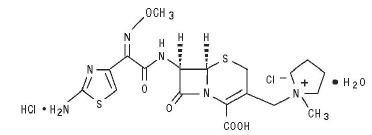
Cefepime hydrochloride (monohydrate) has a molecular mass of 571.50 and a molecular formula of C19H25ClN6O5S2•HCl•H2O.
Cefepime hydrochloride is a white to pale yellow powder. Cefepime hydrochloride contains the equivalent of not less than 825 mcg and not more than 911 mcg of cefepime (C19H24N6O5S2) per mg, calculated on an anhydrous basis. It is highly soluble in water.
Cefepime for Injection USP and Dextrose Injection USP in the DUPLEX® dual chamber container is supplied for intravenous administration in strengths equivalent to 1 g and 2 g of cefepime. Cefepime for Injection USP and Dextrose Injection USP is supplied as a sterile, nonpyrogenic, single-dose packaged combination of cefepime hydrochloride with L-arginine (drug chamber) and 50 mL of 5% dextrose injection (diluent) in the DUPLEX® sterile container.
The powder chamber of the DUPLEX® container contains a sterile, dry mixture of cefepime hydrochloride and L-arginine. It contains the equivalent of not less than 90.0 percent and not more than 115.0 percent of the labeled amount of cefepime (C19H24N6O5S2). The L-arginine, at an approximate concentration of 725 mg/g of cefepime, is added to control the pH of the reconstituted solution at 4.0 – 6.0.
The diluent chamber contains Dextrose Injection USP, an iso-osmotic diluent using Hydrous Dextrose USP in Water for Injection USP. Dextrose Injection USP is sterile, nonpyrogenic, and contains no bacteriostatic or antimicrobial agents. Its empirical formula is C6H12O6•H2O and its molecular weight is 198.17.
Hydrous Dextrose USP has the following structural (molecular) formula:
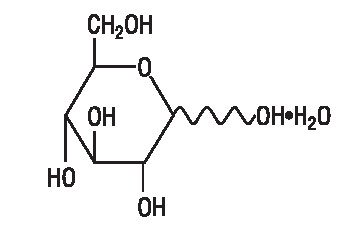
The DUPLEX® container is a flexible dual chamber container. After removing the peelable foil strip, activating the seals, and thoroughly mixing, the reconstituted drug product is hyperosmotic and is intended for single intravenous use. Each 50 mL contains cefepime hydrochloride equivalent to either 1 gram or 2 grams of cefepime. Reconstituted solutions of Cefepime for Injection USP and Dextrose Injection USP range in color from colorless to amber.
The DUPLEX® dual chamber container is made from a specially formulated material. The product (diluent and drug) contact layer is a mixture of thermoplastic rubber and a polypropylene ethylene copolymer that contains no plasticizers. The safety of the container is supported by USP biological evaluation procedures.
12. Cefepime Hydrochloride and Dextrose - Clinical Pharmacology
12.2 Pharmacodynamics
Similar to other beta-lactam antimicrobial agents, the time that the unbound plasma concentration of cefepime exceeds the MIC of the infecting organism has been shown to best correlate with efficacy in animal models of infection. However, the pharmacokinetic/pharmacodynamic relationship for cefepime has not been evaluated in patients.
12.3 Pharmacokinetics
Pharmacokinetic parameters for cefepime in healthy adult male volunteers (n=9) following single 30-minute IV infusions of cefepime 500 mg, 1 g, and 2 g are summarized in Table 5. Elimination of cefepime is principally via renal excretion with an average (±SD) half-life of 2 (±0.3) hours and total body clearance of 120 (±8) mL/min in healthy volunteers. Cefepime pharmacokinetics are linear over the range 250 mg to 2 g. There is no evidence of accumulation in healthy adult male volunteers (n=7) receiving clinically relevant doses for a period of 9 days.
| Parameter | 500 mg IV | 1 g IV | 2 g IV |
|---|---|---|---|
| Cmax, mcg/mL | 39.1 (3.5) | 81.7 (5.1) | 163.9 (25.3) |
| AUC, h∙mcg/mL | 70.8 (6.7) | 148.5 (15.1) | 284.8 (30.6) |
| Number of subjects (male) | 9 | 9 | 9 |
Distribution
The average steady-state volume of distribution of cefepime is 18.0 (±2.0) L. The serum protein binding of cefepime is approximately 20% and is independent of its concentration in serum.
Concentrations of cefepime achieved in specific tissues and body fluids are listed in Table 6.
| Tissue or Fluid | Dose/Route | # of Patients | Average Time of Sample Post-Dose (h) | Average Concentration |
|---|---|---|---|---|
| Blister Fluid | 2 g IV | 6 | 1.5 | 81.4 mcg/mL |
| Bronchial Mucosa | 2 g IV | 20 | 4.8 | 24.1 mcg/g |
| Sputum | 2 g IV | 5 | 4 | 7.4 mcg/mL |
| Urine | 500 mg IV | 8 | 0–4 | 292 mcg/mL |
| 1 g IV | 12 | 0–4 | 926 mcg/mL | |
| 2 g IV | 12 | 0–4 | 3120 mcg/mL | |
| Bile | 2 g IV | 26 | 9.4 | 17.8 mcg/mL |
| Peritoneal Fluid | 2 g IV | 19 | 4.4 | 18.3 mcg/mL |
| Appendix | 2 g IV | 31 | 5.7 | 5.2 mcg/g |
| Gallbladder | 2 g IV | 38 | 8.9 | 11.9 mcg/g |
| Prostate | 2 g IV | 5 | 1 | 31.5 mcg/g |
Data suggest that cefepime does cross the inflamed blood-brain barrier. The clinical relevance of these data are uncertain at this time.
Metabolism and Excretion
Cefepime is metabolized to N-methylpyrrolidine (NMP), which is rapidly converted to the N-oxide (NMP-N-oxide). Urinary recovery of unchanged cefepime accounts for approximately 85% of the administered dose. Less than 1% of the administered dose is recovered from urine as NMP, 6.8% as NMP-N-oxide, and 2.5% as an epimer of cefepime. Because renal excretion is a significant pathway of elimination, patients with renal dysfunction and patients undergoing hemodialysis require dosage adjustment [see Dosage and Administration (2.3)].
Specific Populations
Patients with Renal Impairment
Cefepime pharmacokinetics have been investigated in patients with various degrees of renal impairment (n=30). The average half-life in patients requiring hemodialysis was 13.5 (±2.7) hours and in patients requiring continuous peritoneal dialysis was 19 (±2.0) hours. Cefepime total body clearance decreased proportionally with creatinine clearance in patients with abnormal renal function, which serves as the basis for dosage adjustment recommendations in this group of patients [see Dosage and Administration (2.3)].
Patients with Hepatic Impairment
The pharmacokinetics of cefepime were unaltered in patients with hepatic impairment who received a single 1 g dose (n=11).
Geriatric Patients
Cefepime pharmacokinetics have been investigated in elderly (65 years of age and older) men (n=12) and women (n=12) whose mean (SD) creatinine clearance was 74.0 (±15) mL/min. There appeared to be a decrease in cefepime total body clearance as a function of creatinine clearance. Therefore, dosage administration of cefepime in the elderly should be adjusted as appropriate if the patient's creatinine clearance is 60 mL/min or less [see Dosage and Administration (2.3)].
Pediatric Patients
Cefepime pharmacokinetics have been evaluated in pediatric patients from 2 months to 11 years of age following single and multiple doses on every 8 hours (n=29) and every 12 hours (n=13) schedules. Following a single intravenous dose, total body clearance and the steady-state volume of distribution averaged 3.3 (±1) mL/min/kg and 0.3 (±0.1) L/kg, respectively. The urinary recovery of unchanged cefepime was 60.4 (±30.4)% of the administered dose, and the average renal clearance was 2 (±1.1) mL/min/kg. There were no significant effects of age or gender (25 male vs. 17 female) on total body clearance or volume of distribution, corrected for body weight. No accumulation was seen when cefepime was given at 50 mg per kg every 12 hours (n=13), while Cmax, AUC, and t1/2 were increased about 15% at steady state after 50 mg per kg every 8 hours. The exposure to cefepime following a 50 mg per kg intravenous dose in a pediatric patient is comparable to that in an adult treated with a 2 g intravenous dose. The absolute bioavailability of cefepime after an intramuscular dose of 50 mg per kg was 82.3 (±15)% in eight patients.
12.4 Microbiology
Mechanism of Action
Cefepime is a bactericidal agent that acts by inhibition of bacterial cell wall synthesis. Cefepime has a broad spectrum of in vitro activity that encompasses a wide range of Gram-positive and Gram-negative bacteria. Within bacterial cells, the molecular targets of cefepime are the penicillin binding proteins (PBP).
Antimicrobial Activity
Cefepime has been shown to be active against most isolates of the following microorganisms, both in vitro and in clinical infections [see Indications and Usage (1)]:
- Gram-negative bacteria:
- Enterobacter spp.
- Escherichia coli
- Klebsiella pneumoniae
- Proteus mirabilis
- Pseudomonas aeruginosa
- Gram-positive Bacteria:
- Staphylococcus aureus (methicillin-susceptible isolates only)
- Streptococcus pneumoniae
- Streptococcus pyogenes
- Viridans group streptococci
The following in vitro data are available, but their clinical significance is unknown. At least 90 percent of the following bacteria exhibit an in vitro minimum inhibitory concentration (MIC) less than or equal to the susceptible breakpoint for cefepime against isolates of similar genus or organism group. However, the efficacy of cefepime in treating clinical infections due to these bacteria has not been established in adequate and well-controlled clinical trials.
- Gram-positive bacteria:
- Staphylococcus epidermidis (methicillin-susceptible isolates only)
- Staphylococcus saprophyticus
- Streptococcus agalactiae
NOTE: Most isolates of enterococci e.g., Enterococcus faecalis and methicillin-resistant staphylococci are resistant to cefepime.
- Gram-negative bacteria:
- Acinetobacter calcoaceticus subsp. lwoffii
- Citrobacter diversus
- Citrobacter freundii
- Enterobacter agglomerans
- Haemophilus infuenzae
- Hafnia alvei
- Klebsiella oxytoca
- Moraxella catarrhalis
- Morganella morganii
- Proteus vulgaris
- Providencia rettgeri
- Providencia stuartii
- Serratia marcescens
NOTE: Cefepime is inactive against many isolates of Stenotrophomonas maltophilia.
13. Nonclinical Toxicology
13.1 Carcinogenesis, Mutagenesis, Impairment of Fertility
No animal carcinogenicity studies have been conducted with cefepime. In chromosomal aberration studies, cefepime was positive for clastogenicity in primary human lymphocytes, but negative in Chinese hamster ovary cells. In other in vitro assays (bacterial and mammalian cell mutation, DNA repair in primary rat hepatocytes, and sister chromatid exchange in human lymphocytes), cefepime was negative for genotoxic effects. Moreover, in vivo assessments of cefepime in mice (2 chromosomal aberration and 2 micronucleus studies) were negative for clastogenicity. No untoward effects on fertility were observed in rats when cefepime was administered subcutaneously at doses up to 1000 mg/kg/day (1.6 times the recommended maximum human dose based on body surface area).
14. Clinical Studies
14.1 Febrile Neutropenic Patients
The safety and efficacy of empiric cefepime monotherapy of febrile neutropenic patients have been assessed in two multicenter, randomized trials comparing cefepime monotherapy (at a dose of 2 g intravenously every 8 hours) to ceftazidime monotherapy (at a dose of 2 g intravenously every 8 hours). These studies comprised 317 evaluable patients. Table 7 describes the characteristics of the evaluable patient population.
| Cefepime | Ceftazidime | |
|---|---|---|
| Total | n=164 | n=153 |
| ANC = absolute neutrophil count; SBP = systolic blood pressure | ||
| Median age (yr) | 56 (range, 18 to 82) | 55 (range, 16 to 84) |
| Male | 86 (52%) | 85 (56%) |
| Female | 78 (48%) | 68 (44%) |
| Leukemia | 65 (40%) | 52 (34%) |
| Other hematologic malignancies | 43 (26%) | 36 (24%) |
| Solid tumor | 54 (33%) | 56 (37%) |
| Median ANC nadir (cells/microliter) | 20 (range, 0 to 500) | 20 (range, 0 to 500) |
| Median duration of neutropenia (days) | 6 (range, 0 to 39) | 6 (range, 0 to 32) |
| Indwelling venous catheter | 97 (59%) | 86 (56%) |
| Prophylactic antibacterial drugs | 62 (38%) | 64 (42%) |
| Bone marrow graft | 9 (5%) | 7 (5%) |
| SBP less than 90 mm Hg at entry | 7 (4%) | 2 (1%) |
Table 8 describes the clinical response rates observed. For all outcome measures, cefepime was therapeutically equivalent to ceftazidime.
| % Response |
||
|---|---|---|
| Outcome Measures | Cefepime (n=164) | Ceftazidime (n=153) |
| Primary episode resolved with no treatment modification, no new febrile episodes or infection, and oral antibacterial drugs allowed for completion of treatment | 51 | 55 |
| Primary episode resolved with no treatment modification, no new febrile episodes or infection and no post-treatment oral antibacterial drugs | 34 | 39 |
| Survival, any treatment modification allowed | 93 | 97 |
| Primary episode resolved with no treatment modification and oral antibacterial drugs allowed for completion of treatment | 62 | 67 |
| Primary episode resolved with no treatment modification and no post-treatment oral antibacterial drugs | 46 | 51 |
Insufficient data exist to support the efficacy of cefepime monotherapy in patients at high risk for severe infection (including patients with a history of recent bone marrow transplantation, with hypotension at presentation, with an underlying hematologic malignancy, or with severe or prolonged neutropenia). No data are available in patients with septic shock.
14.2 Complicated Intra-abdominal Infections
Patients hospitalized with complicated intra-abdominal infections participated in a randomized, double-blind, multicenter trial comparing the combination of cefepime (2 g every 12 hours) plus intravenous metronidazole (500 mg every 6 hours) versus imipenem/cilastatin (500 mg every 6 hours) for a maximum duration of 14 days of therapy. The study was designed to demonstrate equivalence of the two therapies. The primary analyses were conducted on the protocol-valid population, which consisted of those with a surgically confirmed complicated infection, at least one pathogen isolated pretreatment, at least 5 days of treatment, and a 4 to 6 week follow-up assessment for cured patients. Subjects in the imipenem/cilastatin arm had higher APACHE II scores at baseline. The treatment groups were otherwise generally comparable with regard to their pretreatment characteristics. The overall clinical cure rate among the protocol-valid patients was 81% (51 cured/63 evaluable patients) in the cefepime plus metronidazole group and 66% (62/94) in the imipenem/cilastatin group. The observed differences in efficacy may have been due to a greater proportion of patients with high APACHE II scores in the imipenem/cilastatin group.
15. References
- Cockcroft DW, Gault MH. Prediction of creatinine clearance from serum creatinine. Nephron. 1976; 16:31–41.
16. How is Cefepime Hydrochloride and Dextrose supplied
Cefepime for Injection USP and Dextrose Injection USP in the DUPLEX® Container is a flexible dual chamber container supplied in two strengths, 1 and 2 g cefepime. The diluent chamber contains approximately 50 mL of 5% Dextrose Injection.
Cefepime for Injection USP and Dextrose Injection USP is supplied sterile and nonpyrogenic in the DUPLEX Container packaged 24 single-dose units per case.
| NDC | REF | Dose | Volume |
|---|---|---|---|
| 0264-3193-11 | 3193-11 | 1 g | 50 mL |
| 0264-3195-11 | 3195-11 | 2 g | 50 mL |
Store the unactivated unit at 20–25°C (68–77°F). Excursions permitted to 15–30°C (59–86°F). [See USP Controlled Room Temperature.] Do not freeze.
Not made with natural rubber latex, PVC or Di(2-ethylhexyl)phthalate (DEHP).
As with other cephalosporins, reconstituted Cefepime for Injection USP and Dextrose Injection USP tends to darken depending on storage conditions, within the stated recommendations. However, product potency is not adversely affected.
Use only if prepared solution is clear and free from particulate matter.
17. Patient Counseling Information
Allergic Reactions
Advise patients that allergic reactions, including serious allergic reactions could occur and that serious reactions require immediate treatment and discontinuation of cefepime. Patients should report to their health care provider any previous allergic reactions to cefepime, cephaloposrins, penicillins, or other similar antibacterial drugs [see Warnings and Precautions (5.1)].
Neurotoxicity
Advise patients of neurological adverse events that could occur with Cefepime for Injection and Dextrose Injection use. Instruct patients or their caregivers to inform their healthcare provider at once of any neurological signs and symptoms, including encephalopathy (disturbance of consciousness including confusion, hallucinations, stupor, and coma), aphasia (disturbance of speaking and understanding spoken and written language), myoclonus, seizures and nonconvulsive status epilepticus, for immediate treatment, dosage adjustment, or discontinuation of Cefepime for Injection and Dextrose Injection [see Warnings and Precautions (5.2)].
Diarrhea
Diarrhea is a common problem caused by antibacterial drugs, which usually ends when the antibacterial drug is discontinued. Inform patient that they may develop watery and bloody stools (with or without stomach cramps and fever) during the treatment and as late as two or more months after having taken the last dose of the antibacterial drug. Inform patients that they should contact their physician as soon as possible if this occurs [see Warnings and Precautions (5.3)].
Antibacterial Resistance
Patients should be counseled that antibacterial drugs including Cefepime for Injection and Dextrose Injection should only be used to treat bacterial infections. They do not treat viral infections (e.g., the common cold). When Cefepime for Injection and Dextrose Injection is prescribed to treat a bacterial infection, patients should be told that although it is common to feel better early in the course of therapy, the medication should be taken exactly as directed. Skipping doses or not completing the full course of therapy may (1) decrease the effectiveness of the immediate treatment and (2) increase the likelihood that bacteria will develop resistance and will not be treatable by Cefepime for Injection and Dextrose Injection or other antibacterial drugs in the future.
B. Braun Medical Inc.
Bethlehem, PA 18018-3524 USA
1-800-227-2862
Prepared in USA.
API from USA and Brazil.
DUPLEX is a registered trademark of B. Braun Medical Inc.
Apache is a registered trademark of Cerner Innovation, Inc.
Rx only
Y36-003-023 LD-107-8
PRINCIPAL DISPLAY PANEL - 1g / 50 mL Container Label
Cefepime for Injection USP
and Dextrose Injection USP
1g*
REF 3193-11
NDC 0264-3193-11
DUPLEX®CONTAINER
50 mL
Use only after mixing contents of both chambers.
For IV Use Only Hyperosmotic Single-Dose Sterile/Nonpyrogenic
* Contains sterile Cefepime Hydrochloride USP equivalent to 1 g of cefepime and
L-arginine for pH adjustment.
After reconstitution each 50 mL single-dose unit contains: Cefepime for Injection
(equivalent to 1 g cefepime) with approximately 2.83 g (5% w/v) Hydrous Dextrose USP in
Water for Injection USP. Approximate osmolality: 431 mOsmol/kg
Prior to Reconstitution: Store at 20-25°C (68-77°F). Excursions permitted to 15-30°C
(59-86°F) [See USP Controlled Room Temperature.] Use only if container and seals are
intact. Do not peel foil strip until ready for use. After foil strip removal, product must be
used within 7 days, but not beyond the labeled expiration date. Protect from light after
removal of foil strip.
Reconstitution: Hold container with set port in a downward direction and fold the
diluent chamber just below the solution meniscus. To activate seal, squeeze folded
diluent chamber until seal between diluent and drug chamber opens, releasing diluent
into drug chamber. Agitate the reconstituted solution until the drug powder is
completely dissolved. Fold the container a second time and squeeze until seal
between drug chamber and set port opens.
After Reconstitution: Use only if prepared solution is clear and free from particulate
matter. Use within 12 hours if stored at room temperature or within 5 days if stored
under refrigeration. Do not use in a series connection. Do not introduce additives into
this container. Prior to administration check for minute leaks by squeezing container
firmly. If leaks are found, discard container and solution as sterility may be impaired.
See package insert for complete directions for reconstitution and administration. Do
not freeze. Discard unused portion.
Not made with natural rubber latex, PVC or DEHP.
Rx only
B. Braun Medical Inc.
Bethlehem, PA 18018-3524
Y37-002-579
LD-210-7
EXP
LOT
Prepared in USA. API from USA and Brazil.
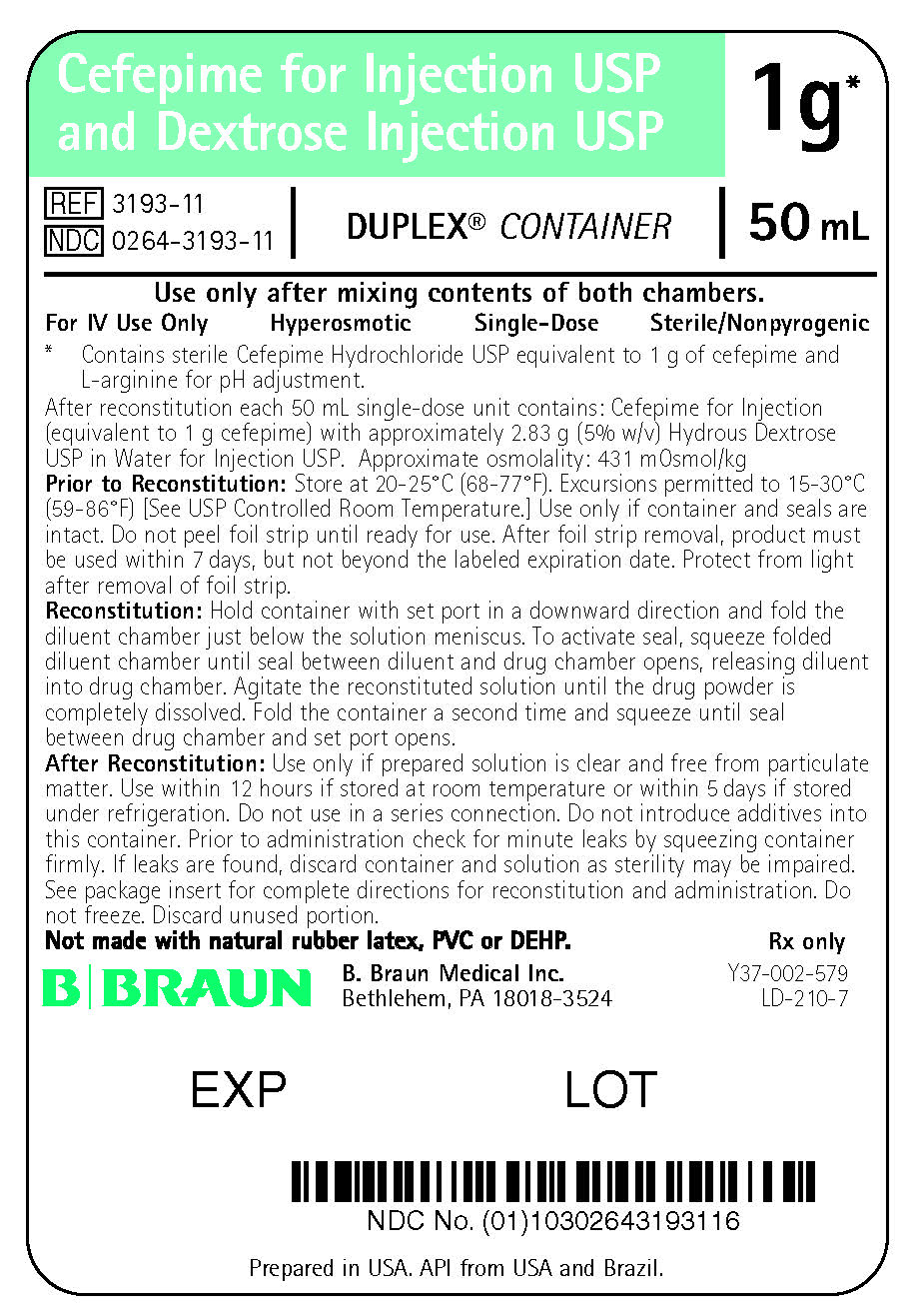
PRINCIPAL DISPLAY PANEL - 2g / 50mL Container Label
Cefepime for Injection USP
and Dextrose Injection USP
2g*
REF 3195-11
NDC 0264-3195-11
DUPLEX®CONTAINER
50 mL
Use only after mixing contents of both chambers.
For IV Use Only Hyperosmotic Single-Dose Sterile/Nonpyrogenic
* Contains sterile Cefepime Hydrochloride USP equivalent to 2 g of cefepime and
L-arginine for pH adjustment.
After reconstitution each 50 mL single-dose unit contains: Cefepime for Injection
(equivalent to 2 g cefepime) with approximately 2.83 g (5% w/v) Hydrous Dextrose
USP in Water for Injection USP. Approximate osmolality: 577 mOsmol/kg
Prior to Reconstitution: Store at 20-25°C (68-77°F). Excursions permitted to 15-30°C
(59-86°F) [See USP Controlled Room Temperature.] Use only if container and seals are
intact. Do not peel foil strip until ready for use. After foil strip removal, product must
be used within 7 days, but not beyond the labeled expiration date. Protect from light
after removal of foil strip.
Reconstitution: Hold container with set port in a downward direction and fold the
diluent chamber just below the solution meniscus. To activate seal, squeeze folded
diluent chamber until seal between diluent and drug chamber opens, releasing diluent
into drug chamber. Agitate the reconstituted solution until the drug powder is
completely dissolved. Fold the container a second time and squeeze until seal
between drug chamber and set port opens.
After Reconstitution: Use only if prepared solution is clear and free from particulate
matter. Use within 12 hours if stored at room temperature or within 5 days if stored
under refrigeration. Do not use in a series connection. Do not introduce additives into
this container. Prior to administration check for minute leaks by squeezing container
firmly. If leaks are found, discard container and solution as sterility may be impaired.
See package insert for complete directions for reconstitution and administration. Do
not freeze. Discard unused portion.
Not made with natural rubber latex, PVC or DEHP.
Rx only
B. Braun Medical Inc.
Bethlehem, PA 18018-3524
Y37-002-580
LD-211-7
EXP
LOT
Prepared in USA. API from USA and Brazil.
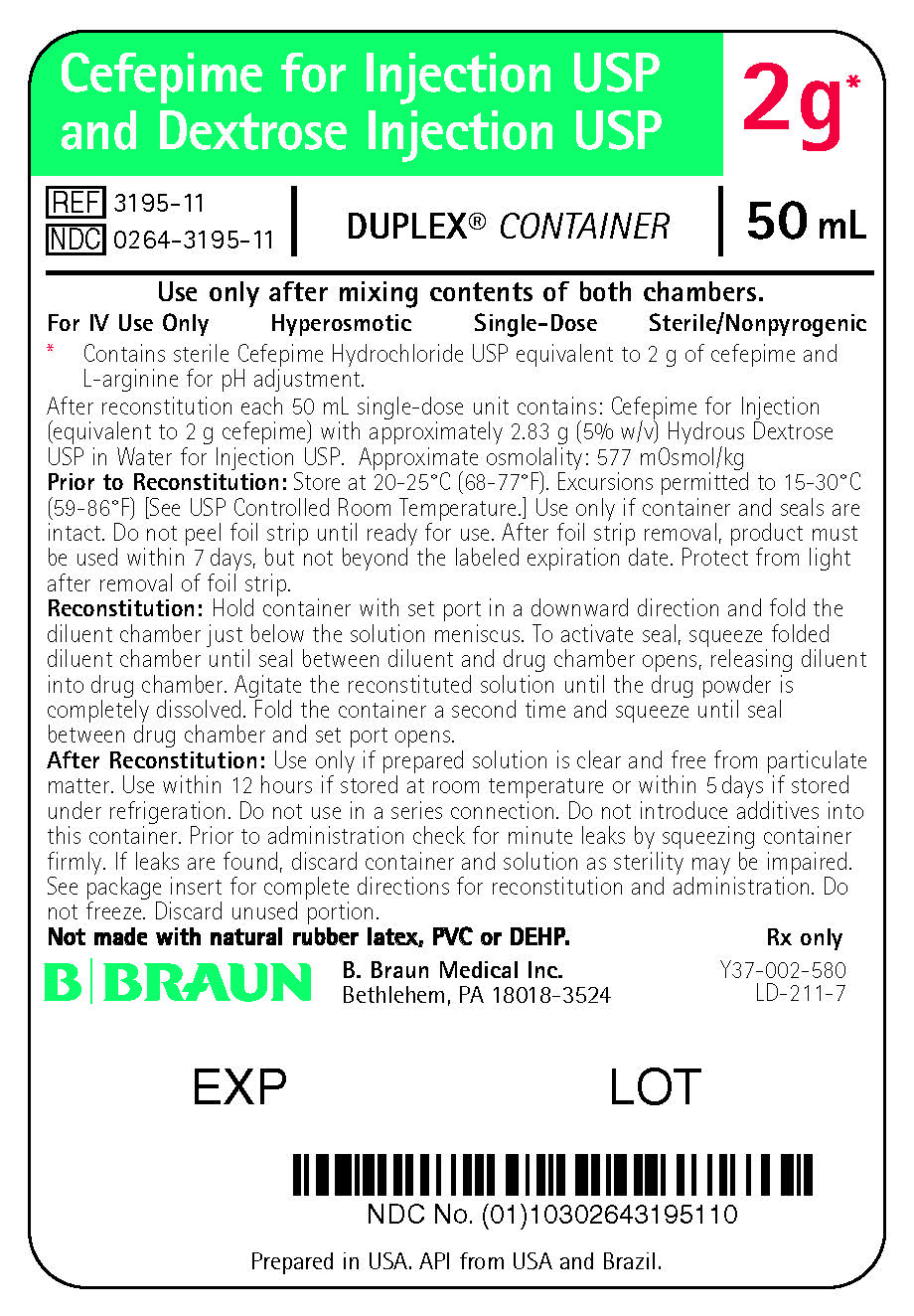
| CEFEPIME HYDROCHLORIDE AND DEXTROSE
cefepime hydrochloride injection, solution |
||||||||||||||||||||
|
||||||||||||||||||||
|
||||||||||||||||||||
|
||||||||||||||||||||
|
||||||||||||||||||||
|
||||||||||||||||||||
|
||||||||||||||||||||
| CEFEPIME HYDROCHLORIDE AND DEXTROSE
cefepime hydrochloride injection, solution |
||||||||||||||||||||
|
||||||||||||||||||||
|
||||||||||||||||||||
|
||||||||||||||||||||
|
||||||||||||||||||||
|
||||||||||||||||||||
|
||||||||||||||||||||
| Labeler - B. Braun Medical Inc. (002397347) |
More about cefepime
- Check interactions
- Compare alternatives
- Pricing & coupons
- Reviews (5)
- Side effects
- Dosage information
- During pregnancy
- Drug class: fourth generation cephalosporins
- Breastfeeding
- En español

